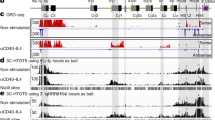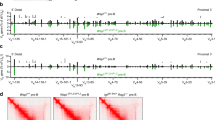Abstract
Variable, diversity and joining gene segment (V(D)J) recombination assembles immunoglobulin heavy or light chain (IgH or IgL) variable region exons in developing bone marrow B cells, whereas class switch recombination (CSR) exchanges IgH constant region exons in peripheral B cells. Both processes use directed DNA double-strand breaks (DSBs) repaired by non-homologous end-joining (NHEJ). Errors in either V(D)J recombination or CSR can initiate chromosomal translocations, including oncogenic IgH locus (Igh) to c-myc (also known as Myc) translocations of peripheral B cell lymphomas. Collaboration between these processes has also been proposed to initiate translocations. However, the occurrence of V(D)J recombination in peripheral B cells is controversial. Here we show that activated NHEJ-deficient splenic B cells accumulate V(D)J-recombination-associated breaks at the lambda IgL locus (Igl), as well as CSR-associated Igh breaks, often in the same cell. Moreover, Igl and Igh breaks are frequently joined to form translocations, a phenomenon associated with specific Igh–Igl co-localization. Igh and c-myc also co-localize in these cells; correspondingly, the introduction of frequent c-myc DSBs robustly promotes Igh–c-myc translocations. Our studies show peripheral B cells that attempt secondary V(D)J recombination, and determine a role for mechanistic factors in promoting recurrent translocations in tumours.
This is a preview of subscription content, access via your institution
Access options
Subscribe to this journal
Receive 51 print issues and online access
$199.00 per year
only $3.90 per issue
Buy this article
- Purchase on Springer Link
- Instant access to full article PDF
Prices may be subject to local taxes which are calculated during checkout




Similar content being viewed by others
References
Jung, D. & Alt, F. W. Unraveling V(D)J recombination; insights into gene regulation. Cell 116, 299–311 (2004)
Rooney, S., Chaudhuri, J. & Alt, F. W. The role of the non-homologous end-joining pathway in lymphocyte development. Immunol. Rev. 200, 115–131 (2004)
Bassing, C. H., Swat, W. & Alt, F. W. The mechanism and regulation of chromosomal V(D)J recombination. Cell 109, S45–S55 (2002)
Gorman, J. R. & Alt, F. W. Regulation of immunoglobulin light chain isotype expression. Adv. Immunol. 69, 113–181 (1998)
Gay, D., Saunders, T., Camper, S. & Weigert, M. Receptor editing: an approach by autoreactive B cells to escape tolerance. J. Exp. Med. 177, 999–1008 (1993)
Tiegs, S. L., Russell, D. M. & Nemazee, D. Receptor editing in self-reactive bone marrow B cells. J. Exp. Med. 177, 1009–1020 (1993)
Nemazee, D. Receptor editing in lymphocyte development and central tolerance. Nature Rev. Immunol. 6, 728–740 (2006)
Jankovic, M., Casellas, R., Yannoutsos, N., Wardemann, H. & Nussenzweig, M. C. RAGs and regulation of autoantibodies. Annu. Rev. Immunol. 22, 485–501 (2004)
Chaudhuri, J. et al. Evolution of the immunoglobulin heavy chain class switch recombination mechanism. Adv. Immunol. 94, 157–214 (2007)
Yan, C. T. et al. IgH class switching and translocations use a robust non-classical end-joining pathway. Nature 449, 478–482 (2007)
Nemazee, D. & Weigert, M. Revising B cell receptors. J. Exp. Med. 191, 1813–1817 (2000)
Seagal, J. & Melamed, D. Role of receptor revision in forming a B cell repertoire. Clin. Immunol. 105, 1–8 (2002)
Wilson, P. C. et al. Receptor revision of immunoglobulin heavy chain variable region genes in normal human B lymphocytes. J. Exp. Med. 191, 1881–1894 (2000)
Goossens, T., Brauninger, A., Klein, U., Kuppers, R. & Rajewsky, K. Receptor revision plays no major role in shaping the receptor repertoire of human memory B cells after the onset of somatic hypermutation. Eur. J. Immunol. 31, 3638–3648 (2001)
Kuppers, R. & Dalla-Favera, R. Mechanisms of chromosomal translocations in B cell lymphomas. Oncogene 20, 5580–5594 (2001)
Janz, S. Myc translocations in B cell and plasma cell neoplasms. DNA Repair (Amst.) 5, 1213–1224 (2006)
Gostissa, M., Ranganath, S., Bianco, J. M. & Alt, F. W. Chromosomal location targets different MYC family gene members for oncogenic translocations. Proc. Natl Acad. Sci. USA 106, 2265–2270 (2009)
Kozubek, S. et al. Distribution of ABL and BCR genes in cell nuclei of normal and irradiated lymphocytes. Blood 89, 4537–4545 (1997)
Neves, H., Ramos, C., da Silva, M. G., Parreira, A. & Parreira, L. The nuclear topography of ABL, BCR, PML, and RARα genes: evidence for gene proximity in specific phases of the cell cycle and stages of hematopoietic differentiation. Blood 93, 1197–1207 (1999)
Nikiforova, M. N. et al. Proximity of chromosomal loci that participate in radiation-induced rearrangements in human cells. Science 290, 138–141 (2000)
Roix, J. J., McQueen, P. G., Munson, P. J., Parada, L. A. & Misteli, T. Spatial proximity of translocation-prone gene loci in human lymphomas. Nature Genet. 34, 287–291 (2003)
Osborne, C. S. et al. Myc dynamically and preferentially relocates to a transcription factory occupied by IgH. PLoS Biol. 5, e192 (2007)
Meaburn, K. J., Misteli, T. & Soutoglou, E. Spatial genome organization in the formation of chromosomal translocations. Semin. Cancer Biol. 17, 80–90 (2007)
Tsai, A. G. et al. Human chromosomal translocations at CpG sites and a theoretical basis for their lineage and stage specificity. Cell 135, 1130–1142 (2008)
Mahowald, G. K., Baron, J. M. & Sleckman, B. P. Collateral damage from antigen receptor gene diversification. Cell 135, 1009–1012 (2008)
Ramiro, A. R. et al. AID is required for c-myc/IgH chromosome translocations in vivo. Cell 118, 431–438 (2004)
Ramiro, A. et al. The role of activation-induced deaminase in antibody diversification and chromosome translocations. Adv. Immunol. 94, 75–107 (2007)
Kovalchuk, A. L. et al. AID-deficient Bcl-xL transgenic mice develop delayed atypical plasma cell tumors with unusual Ig/Myc chromosomal rearrangements. J. Exp. Med. 204, 2989–3001 (2007)
Robbiani, D. F. et al. AID is required for the chromosomal breaks in c-myc that lead to c-myc/IgH translocations. Cell 135, 1028–1038 (2008)
Jager, U. et al. Follicular lymphomas’ BCL-2/IgH junctions contain templated nucleotide insertions: novel insights into the mechanism of t(14;18) translocation. Blood 95, 3520–3529 (2000)
Lieber, M. R., Yu, K. & Raghavan, S. C. Roles of nonhomologous DNA end joining, V(D)J recombination, and class switch recombination in chromosomal translocations. DNA Repair (Amst.) 5, 1234–1245 (2006)
Callen, E. et al. ATM prevents the persistence and propagation of chromosome breaks in lymphocytes. Cell 130, 63–75 (2007)
Li, Z. et al. The XRCC4 gene encodes a novel protein involved in DNA double-strand break repair and V(D)J recombination. Cell 83, 1079–1089 (1995)
Gao, Y. et al. A critical role for DNA end-joining proteins in both lymphogenesis and neurogenesis. Cell 95, 891–902 (1998)
Soulas-Sprauel, P. et al. Role for DNA repair factor XRCC4 in immunoglobulin class switch recombination. J. Exp. Med. 204, 1717–1727 (2007)
Wang, J. H. et al. Oncogenic transformation in the absence of Xrcc4 targets peripheral B cells that have undergone editing and switching. J. Exp. Med. 205, 3079–3090 (2008)
Kraus, M., Alimzhanov, M. B., Rajewsky, N. & Rajewsky, K. Survival of resting mature B lymphocytes depends on BCR signaling via the Igα/β heterodimer. Cell 117, 787–800 (2004)
Muramatsu, M. et al. Class switch recombination and hypermutation require activation-induced cytidine deaminase (AID), a potential RNA editing enzyme. Cell 102, 553–563 (2000)
Gartner, F., Alt, F. W., Monroe, R. J. & Seidl, K. J. Antigen-independent appearance of recombination activating gene (RAG)-positive bone marrow B cells in the spleens of immunized mice. J. Exp. Med. 192, 1745–1754 (2000)
Hao, Z. & Rajewsky, K. Homeostasis of peripheral B cells in the absence of B cell influx from the bone marrow. J. Exp. Med. 194, 1151–1164 (2001)
Schrader, C. E., Linehan, E. K., Mochegova, S. N., Woodland, R. T. & Stavnezer, J. Inducible DNA breaks in Ig S regions are dependent on AID and UNG. J. Exp. Med. 202, 561–568 (2005)
Plessis, A., Perrin, A., Haber, J. E. & Dujon, B. Site-specific recombination determined by I-SceI, a mitochondrial group I intron-encoded endonuclease expressed in the yeast nucleus. Genetics 130, 451–460 (1992)
Zarrin, A. A. et al. Antibody class switching mediated by yeast endonuclease-generated DNA breaks. Science 315, 377–381 (2007)
Lahvis, G. P. & Cerny, J. Induction of germinal center B cell markers in vitro by activated CD4+ T lymphocytes: the role of CD40 ligand, soluble factors, and B cell antigen receptor cross-linking. J. Immunol. 159, 1783–1793 (1997)
Monroe, R. J. et al. RAG2:GFP knockin mice reveal novel aspects of RAG2 expression in primary and peripheral lymphoid tissues. Immunity 11, 201–212 (1999)
Yu, W. et al. Continued RAG expression in late stages of B cell development and no apparent re-induction after immunization. Nature 400, 682–687 (1999)
Cremer, T. & Cremer, C. Chromosome territories, nuclear architecture and gene regulation in mammalian cells. Nature Rev. Genet. 2, 292–301 (2001)
Zhu, C. et al. Unrepaired DNA breaks in p53-deficient cells lead to oncogenic gene amplification subsequent to translocations. Cell 109, 811–821 (2002)
Roth, D. B. Amplifying mechanisms of lymphomagenesis. Mol. Cell 10, 1–2 (2002)
McVey, M. & Lee, S. E. MMEJ repair of double-strand breaks (director’s cut): deleted sequences and alternative endings. Trends Genet. 24, 529–538 (2008)
Acknowledgements
We thank Alt laboratory members for discussions, and Y. L. Chen, J. M. Bianco and M. Moghimi for technical assistance. This work was supported by the National Insitutes of Health (NIH) grant 5P01CA92625 and a Leukemia and Lymphoma Society of America (LLS) SCORE grant to F.W.A. and K.R. M.G. is and J.H.W. was a Special Fellow of the LLS. J.H.W. and D.R.W. are supported by an NIH training grant and C.T.Y. was supported by an NCI training grant. A.N. is supported by the Intramural Research program of the NIH, NCI, Center for Cancer Research. F.W.A. is an Investigator of the Howard Hughes Medical Institute.
Author Contributions F.W.A., J.H.W., M.G. and C.T.Y. planned studies and interpreted data. J.H.W. performed most experiments, including mouse breeding, B cell studies, FISH, and Igh and Igl PCR studies. C.T.Y. bred mice and performed B cell analyses. M.G. generated and analysed c-myc25IsceI/WT mice and performed FISH and Igh–c-myc translocation studies. P.G., T.H., and E.H. provided technical assistance. S.D. and A.N. provided expertise in 3D interphase FISH. A.A.Z. generated the 25 IsceI array. D.R.W. performed RAG expression studies and mesenteric lymph node B cell analyses. K.R. provided RAG conditional knockout mice and helped interpret data. F.W.A., J.H.W. and M.G. wrote the paper.
Author information
Authors and Affiliations
Corresponding author
Supplementary information
Supplementary Information
This file contains Supplementary Figures 1-15 with Legends and Supplementary Tables 1-16. (PDF 5154 kb)
Rights and permissions
About this article
Cite this article
Wang, J., Gostissa, M., Yan, C. et al. Mechanisms promoting translocations in editing and switching peripheral B cells. Nature 460, 231–236 (2009). https://doi.org/10.1038/nature08159
Received:
Accepted:
Issue Date:
DOI: https://doi.org/10.1038/nature08159
This article is cited by
-
HDAC inhibitors overcome immunotherapy resistance in B-cell lymphoma
Protein & Cell (2020)
-
The nucleoskeleton protein IFFO1 immobilizes broken DNA and suppresses chromosome translocation during tumorigenesis
Nature Cell Biology (2019)
-
A multiple myeloma-specific capture sequencing platform discovers novel translocations and frequent, risk-associated point mutations in IGLL5
Blood Cancer Journal (2018)
-
Contribution of classical end-joining to PTEN inactivation in p53-mediated glioblastoma formation and drug-resistant survival
Nature Communications (2017)
-
Rad52 competes with Ku70/Ku86 for binding to S-region DSB ends to modulate antibody class-switch DNA recombination
Nature Communications (2017)
Comments
By submitting a comment you agree to abide by our Terms and Community Guidelines. If you find something abusive or that does not comply with our terms or guidelines please flag it as inappropriate.



